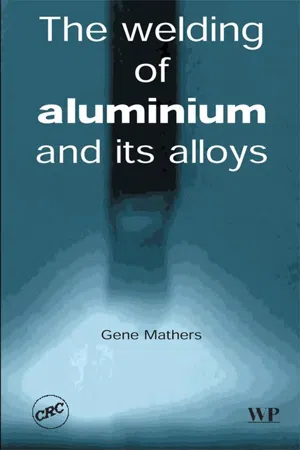
- 248 pages
- English
- ePUB (mobile friendly)
- Available on iOS & Android
The Welding of Aluminium and Its Alloys
About this book
The Welding of Aluminium and its Alloys is a practical user's guide to all aspects of welding aluminium and aluminium alloys. It provides a basic understanding of the metallurgical principles involved showing how alloys achieve their strength and how the process of welding can affect these properties. The book is intended to provide engineers with perhaps little prior understanding of metallurgy and only a brief acquaintance with the welding processes involved with a concise and effective reference to the subject.It is intended as a practical guide for the Welding Engineer and covers weldability of aluminium alloys; process descriptions, advantages, limitations, proposed weld parameters, health and safety issues; preparation for welding, quality assurance and quality control issues along with problem solving.The book includes sections on parent metal storage and preparation prior to welding. It describes the more frequently encountered processes and has recommendations on welding parameters that may be used as a starting point for the development of a viable welding procedure. Included in these chapters are hints and tips to avoid some of the pitfalls of welding these sometimes-problematic materials. The content is both descriptive and qualitative. The author has avoided the use of mathematical expressions to describe the effects of welding.This book is essential reading for welding engineers, production engineers, production managers, designers and shop-floor supervisors involved in the aluminium fabrication industry.- A practical user's guide by a respected expert to all aspects of welding of aluminium- Designed to be easily understood by the non-metallurgist whilst covering the most necessary metallurgical aspects- Demonstrates best practice in fabricating aluminium structures
Frequently asked questions
- Essential is ideal for learners and professionals who enjoy exploring a wide range of subjects. Access the Essential Library with 800,000+ trusted titles and best-sellers across business, personal growth, and the humanities. Includes unlimited reading time and Standard Read Aloud voice.
- Complete: Perfect for advanced learners and researchers needing full, unrestricted access. Unlock 1.4M+ books across hundreds of subjects, including academic and specialized titles. The Complete Plan also includes advanced features like Premium Read Aloud and Research Assistant.
Please note we cannot support devices running on iOS 13 and Android 7 or earlier. Learn more about using the app.
Information
Introduction to the welding of aluminium
1.1 Introduction



1.2 Characteristics of aluminium
Table of contents
- Cover image
- Title page
- Table of Contents
- Copyright page
- Preface
- 1: Introduction to the welding of aluminium
- 2: Welding metallurgy
- 3: Material standards, designations and alloys
- 4: Preparation for welding
- 5: Welding design
- 6: TIG welding
- 7: MIG welding
- 8: Other welding processes
- 9: Resistance welding processes
- 10: Welding procedure and welder approval
- 11: Weld defects and quality control
- Appendix A: British and ISO standards related to welding and aluminium
- Appendix B: Physical, mechanical and chemical properties at 20°C
- Appendix C: Principal alloy designations: cast products
- Appendix D: Alloy designations: wrought products
- Bibliography
- Index